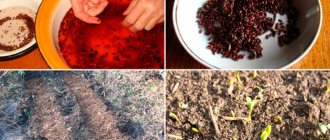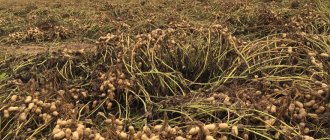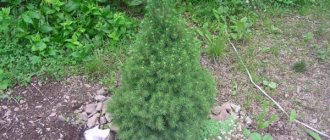It’s hard to imagine modern cuisine without garlic. Moreover, the taste of homemade garlic is not comparable to store-bought. More often, store-bought is brought from China, where it is grown using completely different technologies. This kind of garlic quickly deteriorates and does not have the pungency and characteristic smell that homemade garlic has. Therefore, every self-respecting gardener always plants winter garlic before winter, and spring garlic in the spring. It is better to plant both varieties; if one of them does not produce a harvest, the other variety will help out. And it seems that its cultivation does not present any particular difficulties, however, for a good harvest you need to know some features. We'll tell you about them.
When to plant summer garlic
Spring varieties are planted in the soil in mid-April - early May. At this time, the soil is still quite moist, and frosts are no longer so severe. The crop does not like dry and warm soil, so it is more rational to plant it as soon as the snow melts. The soil temperature at this time warms up to 5-7 ºС.
Such conditions in the Moscow region begin on the 20th of April, in the southern regions 2-3 weeks earlier. In the northern regions, on the contrary, it is better to plant 2-3 weeks later, that is, in the last days of April - the first days of May. At the same time, different temperatures for growth and development are needed.
- And at the initial stage of the growing season, 10-15ºС is sufficient;
- During the period of teeth formation – 15-20 ºС;
- For ripening, a temperature of 20-25 ºС is required.
When warm weather arrives and the earth warms up more, the plant stops developing and the bulb stops forming.
Preparing the soil for planting spring garlic
It is better to prepare the soil for planting from autumn to early spring. As soon as the soil conditions allow, level the surface of the bed and make grooves for planting. When preparing the soil, per 1 sq. m add 20 g of superphosphate, 1 glass of wood ash, and a bucket of humus.
If it was not possible to prepare the beds in the fall, you can dig up the beds in the spring after the snow has melted. Dig the soil to the depth of a shovel and fill the soil with humus and wood ash.
Preparation of planting material
Healthy, strong bulbs are selected for planting. Immediately before sowing, the onions are disassembled into individual cloves. Moreover, cloves located in two outer rows are suitable for planting. The inner cloves are small, they will not grow into good garlic, they are left for eating. The yield of garlic directly depends on the size of the teeth.
The prepared teeth are wrapped in a towel soaked in cold water and stored for several days in a cool place, for example, in the refrigerator. A few hours before planting, the planting material is taken out and left at room temperature. Disinfection is carried out for several minutes in a pink solution of potassium permanganate or in a 1% solution of copper sulfate. For disinfection, you can use an ash solution (400 g of ash is diluted in 2 liters of water, boiled for 30 minutes), soaked for 2 hours.
Common Mistakes
The most common mistakes when sowing are:
- Incorrect sowing time. As soon as the snow has melted, you should plant garlic before the soil warms up. If you are late with sowing, the harvest will decrease by 2 times.
- Wrong choice of location. Spring garlic is poorly affected by temperature changes, so you should plant it in a well-lit place with sunshine and make sure there are no drafts. It is also wrong to plant garlic in lowlands, as water will stagnate there.
- Do not buy planting material in the store, since it is not known how long ago it was collected and how it was stored. In this case, you cannot be sure that you will get a good harvest of tasty garlic.
- Do not use small cloves for planting.
From the video we will learn the secrets and subtleties of planting spring garlic in the spring - what the planting material should be, when and how to plant it correctly:
Planting spring garlic is quite simple and caring for it does not present any difficulties. You just need to follow the planting rules and take into account all the tricks, and then you will get a good harvest of delicious spring garlic. This means that there will be vitamins on your table all year round.
0
0
Copy link
Planting spring garlic
In beds with prepared soil, make longitudinal grooves 2-3 cm deep. The distance between the rows is 20 cm, and in the row itself between the cloves - 5-6 cm. Since the cloves of spring garlic are smaller, therefore, unlike winter garlic, garlic is not planted deep . They are stuck shallowly into the soil, trying not to bury them too deep.
At first, in the first month before germination, garlic grows slowly. When the root system is formed, the growth of the plant accelerates significantly. As for the period of teeth growth itself, it lasts 3-4 weeks.
Sometimes garlic is grown from seeds. When they are planted, single-toothed bulbs grow towards the end of the growing season. Garlic seeds are obtained from bulbs. After a season, the one-toothed ones are used to grow full-fledged heads. Garlic seeds are very small and have good keeping quality.
The planted garlic is covered with mulch on top; for this, hay, straw, sawdust, etc. are used. Mulching is done so that the top layer does not warm up too much at first and does not dry out.
Selecting a location
Choosing a suitable location is an important point in growing quality garlic. One of the most important criteria in the choice is what plants were in the place where it is now planned to sow garlic.
So, it is best to plant it in the soil after legumes, cabbage, pumpkin or grain crops. In such land, garlic will be enriched with useful substances that remained after these crops, and this will give it the opportunity to grow faster and produce a larger harvest.
We do not recommend planting vegetables in the same place where they grew last year. The position must be changed every time so that the plant receives enough nutrients from the soil and grows well.
The worst predecessors of spring garlic are potatoes, tomatoes and onions. Do not sow garlic in areas where these species were previously planted. Since it will not receive all the vitamins necessary for growth, it will grow more slowly and remain small and tasteless.
If you choose a shaded area for garlic, you will get a lot of greenery, and a sunny place will produce large and juicy heads of the vegetable.
Caring for garlic plantings
Caring for garlic is not much different from caring for its winter counterpart or onions. To grow a good harvest, it takes all season
- timely watering,
- feeding every 2-3 weeks,
- weed removal and loosening,
- control of diseases and pests.
Watering
The plant is very demanding of soil moisture. Therefore, during the first two months from the emergence of seedlings, the soil must be kept moist and watered. In the absence of rain, watering is mandatory, and the soil must be watered, shedding the soil deeply.
However, remember to be careful not to overwater. Although garlic grows well in moist soil, if there is too much moisture, the plant can rot.
Feeding
Garlic is very responsive to fertilizers. To do this, in early June, when the height of the green stems is 6-10 cm, it is time to apply nitrogen fertilizers. A solution of mullein and urea is better suited: add 1 tbsp to a 10-liter bucket of water. l. urea and 1 glass of mullein, let it brew for 5-6 hours. Water the plants under the roots at the rate of 3 liters of solution per 1 square meter. m.
Then, during the period of formation of 5 leaves, it is fed at the root with a solution of potassium permanganate or an infusion of green herbs.
During the formation of the bulbs, feed:
- superphosphate solution (per 10 liters of water + 2 tablespoons of superphosphate);
- infusion of wood ash (150 g of ash per bucket of water).
Feeding is carried out 3-4 times during the summer. When fertilizing, it is important to maintain proportions, otherwise the garlic heads may crack due to an excess of fertilizers.
Pest Control
Most often, garlic is affected by the onion fly. Fighting the onion fly is quite difficult, but there are still effective ways to help cope with the pest.
Sometimes the heads are affected by root mites. The female of this pest lays eggs directly in the cloves, which subsequently rot. More often, such a pest appears if garlic was preceded by planting tomatoes, cabbage or cucumbers. Therefore, it is important to observe garlic crop rotation and choose good predecessors.
Garlic diseases
The following diseases most often affect garlic:
- Cervical rot;
- Bacteriosis,
- Green mold,
- Yellow dwarfism.
As a rule, pathogens penetrate the tissue of the head through mechanical damage that appears during the process of caring for the plant. The trouble is that the signs of disease are not immediately recognized. Only some time after the start of storage, signs of disease can be seen on the cloves: discoloration, softening and rotting of the onion tissue.
The best varieties
All varieties of spring garlic developed today are distinguished by their good tolerance of spring frosts. There are many varieties of spring garlic that gardeners love to grow. These include:
- Abrek;
- Kledor;
- Elenovsky;
- Aleysky;
- Victorio;
- Ershovsky.
Let's look at the features of each variety.
Abrek
One head of the Abrek variety most often contains 15 cloves , which are formed into a flattened-round bulb weighing 30 g. It is covered with white dry scales. The pulp is dense, white and pungent in taste.
The Abrek variety is considered the best due to its high yield of up to 1 kg/m2 and long-term storage of up to 7 months. In many ways, Aleysky garlic is considered the best because of its resistance to sudden temperature changes.
Kledor
The elite mid-season variety Kledor has a head with a diameter of 5-6 cm, which contains about 20 cloves. They are arranged in a spiral. The pulp of garlic is white-cream, dense structure, mildly spicy taste . This variety stores well, stores well and has excellent taste.
Important : the Kledor variety is very resistant to bacterial and fungal diseases.
Elenovsky
The shape of the Elenovsky garlic bulb is rounded-flat or rounded . Weighs 30-40 g. It most often contains 25 pieces of creamy pink semi-sharp cloves. The shelf life can be up to 2 years. The variety is characterized by high yield per 1 hectare - up to 3.7 tons of bulbs.
Aleysky
With proper care, Aleisky garlic gives a good harvest. The heads are dense, weighing up to 35 g, and have a bitter taste. On average there are 19 pieces. It is well preserved, but is not resistant to fusarium and bacterial rot.
Victorio
Victorio garlic has a moderately pungent taste and yellowish-white, dense bulbs . Their weight reaches 40 g, they have from 10 to 13 cloves. Garlic keeps well for 8 months. Advantages: high yield and disease resistance.
Ershovsky
The Ershovsky variety has small snow-white heads containing from 18 to 25 semi-sharp cloves. This garlic stands out:
- high productivity;
- excellent immunity to diseases;
- versatility in use.
Harvest
Spring garlic is harvested 1 month after winter harvest. Usually this is the end of August - beginning of September. Signs of harvest readiness are yellowing of the lower leaves and lodging of the upper ones. 2-3 weeks before harvesting, stop watering the garlic. To harvest garlic, choose a dry day.
The heads of garlic are removed from the ground using a fork or a small spatula, being careful not to damage the garlic itself. The remaining soil is shaken off and the plants and tops are removed to dry in a ventilated room for 5-7 days.
The harvested crop is sorted into 2 parts:
- planting material,
- onions for food.
To do this, larger onions are left for planting, and medium-sized onions are left for eating. The main condition for selecting planting material is the absence of mechanical damage and signs of disease on the bulbs. The cloves themselves should be strong and dense.
Description of culture
Externally, garlic is shaped like an onion, slightly flattened at the edges, however, the structure of this vegetable is much more complex. So, inside the “bulb” is divided into several so-called sinuses, inside each of which, depending on the variety, from 2 to 50 teeth can be formed.
The cloves themselves are oblong in shape and can be of absolutely any size. Their color is usually:
- white;
- yellowish.
However, in addition to the traditional shades of the vegetable, there may be cloves colored in:
- pinkish tint;
- rich lilac color.
The leaves of the spring variety of garlic look traditional:
- they are narrow;
- have a lancet shape;
- stretch upward;
- the endings are sharp.
Spring garlic leaves are also readily used as food, as they are very juicy and have a mild taste.
The width of such a garlic leaf usually reaches a centimeter, but it sometimes grows up to a meter in height. The stem of the crop has a generally complex structure, so subsequent leaves grow from the axils of the previous ones.
This plant also produces shoots, which are often eaten fried. The height of the arrow is 70-140 centimeters. The end of the arrow is a curved tail, topped with an inflorescence, which then transforms into a box containing a small amount of seeds.
Storing spring garlic
The roots of dried garlic are carefully cut off, and the dried tops are shortened to 10 cm. The harvested crop is stored in a cool, dry place. To preserve the harvest until spring, garlic heads are periodically checked for signs of disease. Damaged bulbs are removed immediately.
With the remains of the tops, the bulbs are woven into braids or bundles, and in this form they are stored in a ventilated room or on the walls. If you cut the tops shorter, then the garlic can be stored simply in a basket, in a nylon net, or in wooden boxes.
Peeled garlic cloves can be stored in a jar with salt or vegetable oil. By storing garlic in oil, you will also get very tasty garlic oil, which you can use to dress salads.
I wish you good harvests!
Possible problems during cultivation
It must be borne in mind that spring garlic cannot adapt well to other environmental conditions . Therefore, it is recommended to grow those varieties that are adapted exclusively to local conditions.
Another problem is the possibility of damage by fungal diseases, which means it is necessary to carry out preventive measures. They consist of treating the cloves with fungicides and providing ventilation for growing plants.
Important : stem nematode can cause great damage to garlic plantings. It dries up because the worms feed on its juice.











